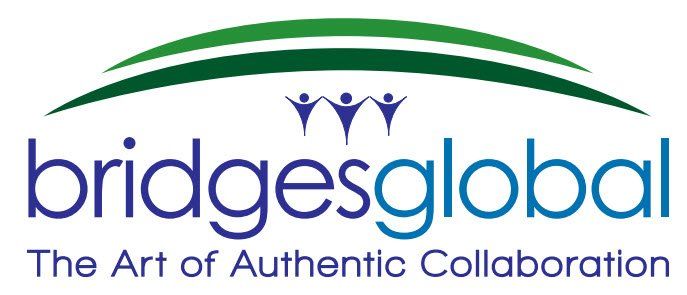The Bridging Leaders Program
Growing Collaborative Leadership
to Expand Social & Climate Justice
Growing Collaborative Leadership
to Expand Social & Climate Justice
The Bridging Leaders Program Objectives
- Develop collaborative leadership and build capacity with a learning-by-doing approach
- Empower change-makers to work together to implement sustainable solutions
Intentions
- Introduce and practice a new holistic, integrated collaboration paradigm to respect self, others and Earth
- Link leaders' inner purpose with outer action to respond to complex social justice and eco-challenges
- Foster personal growth, organizational effectiveness and community development with a leadership-in-action pathway
“We cannot solve problems by using the same kind of thinking we used when we created them.” A. Einstein
Overview
The Bridging Leaders Program (BLP) transforms the way people collaborate by practicing effective ways to think, speak, listen and interact. Formerly a UN flagship program, BLP blends inner transformation with outer action. Tangible outcomes are achieved with Innovation Projects.
Each leadership team designs and implements an
Innovation Project in order to
produce a high-impact solution, benefiting the organization
and
society at large. The projects also become a living laboratory to experiment with new behaviours and tools.
We believe that the wisdom is within. So, our facilitation is geared to unleash people's creativity. Our style is dynamic, interactive, experiential and uplifting. We specialize in empowering people in disempowering environments. Leadership competencies include systems-thinking, authentic collaboration, conscious engagement, power-sharing partnerships, project management, heart-centred relating, emotional intelligence, conflict mastery and the art of influence. Participants enjoy learning in a brave space that nurtures community and a sense of belonging.
Possible Innovation Project Result Areas
In addressing complex social justice and environmental issues, result areas can focus on forest conservation and restoration, water pollution clean-up, regenerative agriculture/food security, sustainable energy, enhanced CSR-low carbon business practices, gender equality or youth empowerment. The host organization chooses result areas that are relevant to their context. Content and team coaching is real-world oriented.
Participants
Each BLP is customized to the host's needs, audience and conditions. There may be one participating organization with various departments, branches or networks engaged. Or there may be several organizations who want to collaborate on a shared goal. However the program is constructed, participating organizations nominate mid-level leaders based on pre-set criteria. Cohorts typically consist of 35-55 change-makers. Ideally, the participant mix is diverse to include people from different disciplines, sectors, generations and cultures.
Hybrid Program Outline
Option A:
Leaders attend 3 in-person 3 day workshops over 6 months, supported by an online learning and project coaching platform.
Option B:
Leaders attend 2 in-person 4 day workshops to bookend the program, with a facilitated online 6 month learning platform.
Option C:
Leaders attend 2 day in-person workshops every 6 weeks over 6 months. The range and depth of online learning is negotiated.
Why Now?
We are facing complex social and ecological challenges that require a different quality of leadership. This translates into fresh thinking, an inclusive range of perspectives and inspired action. Well-tested in many cultures, BLP unlocks potential so people can bring more of who they are to the table to work better together. With multi-layered issues, BLP supports leaders as they explore leverage opportunities to evolve cultures and shift untenable systems. Now is the time to harness our power and take bold, courageous action. We are the ones we've been waiting for.
Success Stories
The predecessor of this program has been implemented by the UN in over 30 countries.
The goal is to build leadership capacity while generating organizational and community results.

Climate Action Innovation Projects
- A group of bankers in Ghana adopted a polluted river to rehabilitate, evolving their corporate social responsibility policy from cheque-writing to hands-on engagement. The river became clean drinking water for the first time in decades.
- A research institute developed a rainwater harvesting and catchment plan to support new municipal building code regulations. As such, household dependence on the water supply was reduced and water stress was alleviated.
- The Ethiopian Ministry of Energy overhauled its renewable energy policy to reduce the country’s carbon footprint. The team exceeded international agreements. This initiative was coupled with a community-wide reforestation program.
- Five waste management companies in Ghana joined together to develop the first household recycling program in the country. This effort was combined with an eco-program to educate the community on waste issues.
- A Congo government disaster prevention agency partnered with a village with a high risk of flooding. They implemented a flood pole device to show rising water levels so citizens could act quickly to save crops, property and lives.
- The Ethiopian Ministry of Industry implemented a new environmental consulting division to support private sector companies in reducing their carbon footprint and becoming more energy efficient.
- The Ethiopian Ministry of Transportation improved food security by introducing a five-year infrastructure plan to develop a climate-friendly railroad system to transport food, grains and other products to the vulnerable north.
“It takes a small group of committed citizens to change the world.
Indeed, it’s the only thing that ever does.”
Margaret Mead
